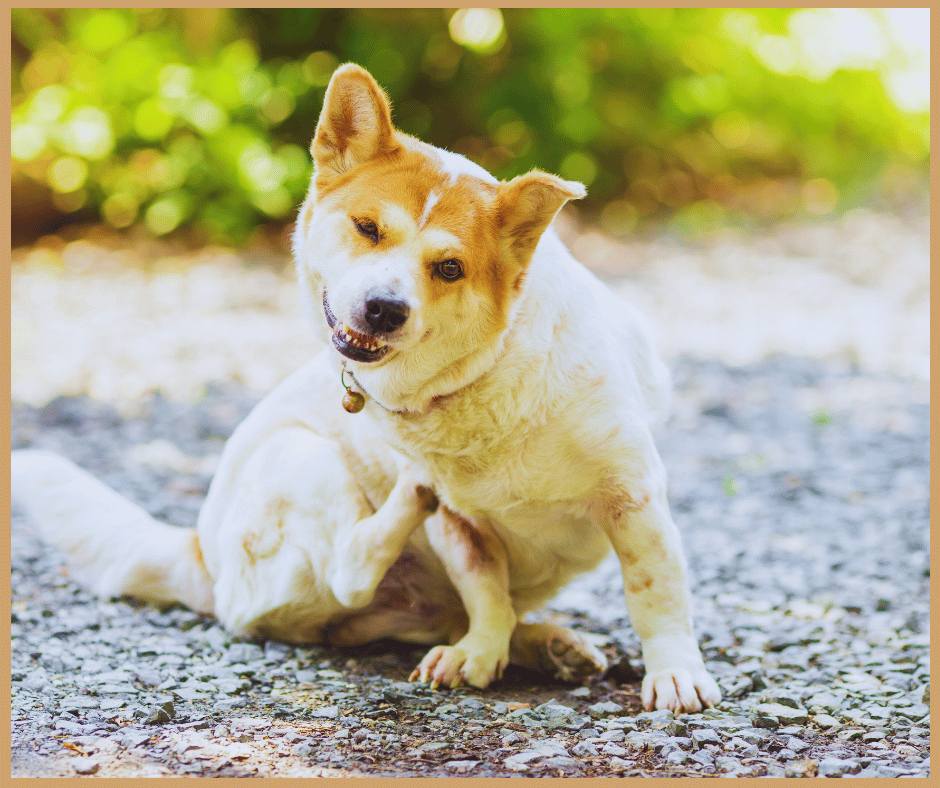Winter is harsh on everyone, including our Dog’s Health. One common issue that dogs face during the colder months is dry skin, which can lead to itching, flakiness, and discomfort.
As pet owners, we must help our dogs stay comfortable and healthy without relying on harsh chemicals or medications. Natural remedies offer a gentle, effective way to soothe your dog’s dry skin at home.
In this Article, we’ll explore some of the best natural treatments to alleviate dry skin in dogs, including dietary changes, home remedies, and preventive measures.
At the end of this Article, you’ll have practical tips for keeping your dog’s skin moisturized and healthy all winter.
Identifying Dry Skin in Dogs
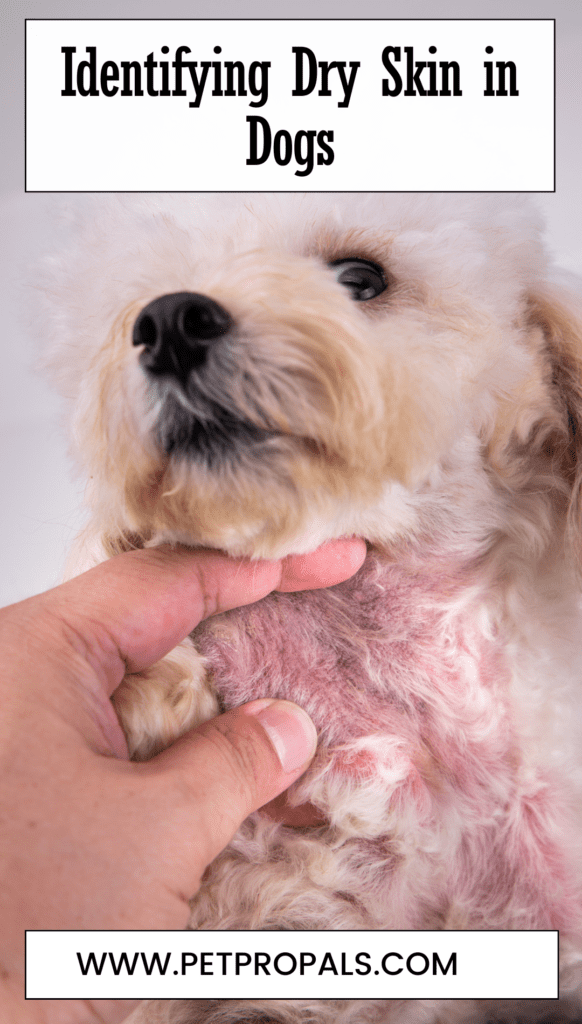
It’s more than just a minor inconvenience when dogs have dry skin. Not treating it can lead to discomfort, excessive scratching, and even secondary infections.
To ensure your pet’s well-being and happiness, it’s essential to identify the indications of dry skin and understand when professional veterinary care might be needed.
Read how to identify dry skin in dogs and when to consult a vet.
1. Common Symptoms
Identifying the signs of dry skin in your dog is crucial for addressing the issue. Typical symptoms include:
Flakiness and Dandruff: One of the most noticeable signs of dry skin is the appearance of white flakes on your dog’s fur, similar to dandruff in humans. These flakes are usually more visible on darker fur.
Itching and Scratching: If your dog is scratching more than usual, especially in specific areas, it could be a sign of dry skin. Pay attention to any areas your dog seems to focus on.
Red or Irritated Skin: Dry skin can lead to redness and irritation. You might notice these changes in areas where the fur is thinner or scratched.
Hair Loss: Patches of hair loss can occur due to excessive scratching or the underlying dryness itself. This can be a more severe sign that requires immediate attention.
Scabs or Sores: Persistent itching and scratching can cause the skin to break, leading to scabs or sores. If not treated properly, these can become infected.
2. When to Consult a Vet
While many instances of dry skin can be handled at home using natural remedies, there are occasions when professional assistance becomes essential. It’s advisable to consult your veterinarian if:
Symptoms Persist: If your dog’s dry skin continues despite using natural remedies, it may indicate an underlying health issue that needs professional treatment.
Severe Itching: Excessive scratching that leads to bleeding or open sores should be evaluated by a vet to prevent infections and further complications.
Behavioral Changes: Significant changes in your dog’s behavior, such as lethargy or irritability, can indicate that dry skin is part of a more significant health problem.
Secondary Infections: Signs of infection, such as pus, swelling, or a foul odor, require immediate veterinary care. Infections can worsen quickly and cause more severe health issues.
Home Remedies for Dry Skin in Dogs
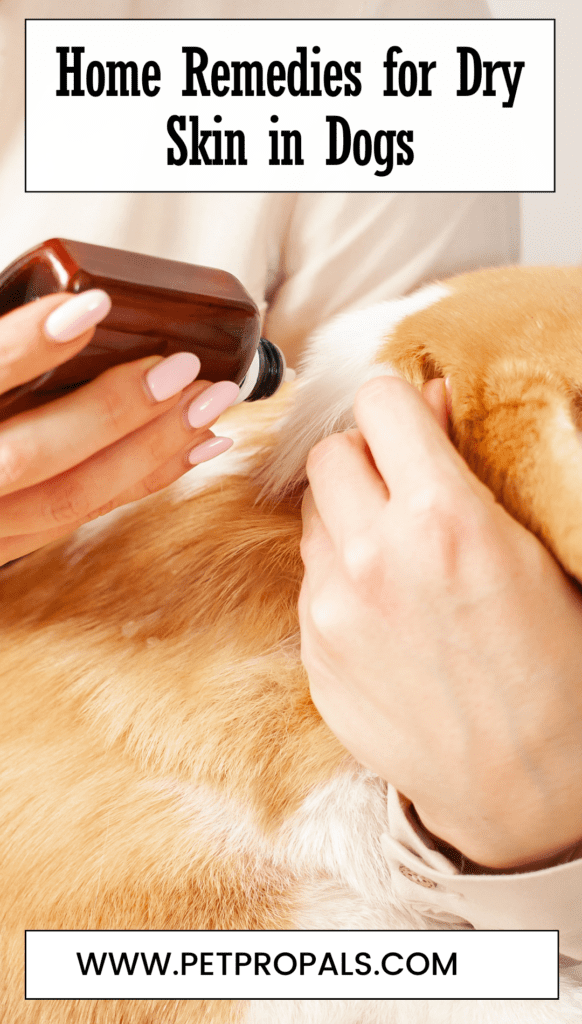
Dry skin in dogs can be a common issue, especially in winter. You can, using natural remedies, effectively manage and soothe your dog’s dry skin at home using nae some gentle and effective options to help alleviate your dog’s dry skin discomfort during the colder seasons:
1. Oatmeal Baths
Oatmeal is famous for its soothing properties and can effectively alleviate itching and irritation caused by dry skin. It creates a protective barrier on the skin, sealing moisture and aiding in healing.
Step-by-step guide:
Prepare the Bath: Fill a bathtub or basin with warm (not hot) water.
Add Oatmeal: Mix plain, finely ground oatmeal into the water. Stir until the water becomes milky.
Bathe Your Dog: Place your dog in the oatmeal bath and gently massage the water into their fur and skin. Avoid getting water in their ears and eyes.
Soak and Rinse: Let your dog soak in the oatmeal bath for 10-15 minutes. Then, rinse them thoroughly with lukewarm water.
Dry Off: Pat your dog dry gently with a towel to avoid further skin irritation.
2. Coconut Oil
Coconut oil is rich in fatty acids that effectively hydrate and nourish your dog’s skin, promoting overall skin health. Additionally, its antimicrobial properties help protect against infections and reduce inflammation.
How to Apply:
Choose Virgin Coconut Oil: Opt for organic, virgin coconut oil free from additives.
Apply Topically: Gently massage a small amount of coconut oil onto your dog’s dry skin, focusing on areas prone to dryness and irritation.
Monitor Absorption: Allow the coconut oil to absorb into the skin. Your dog may try to lick it off, so keep an eye on them to prevent excessive ingestion.
3. Olive Oil
Olive oil is another natural moisturizer for your dog’s skin and coat. It contains antioxidants and healthy fats that support skin health from the inside out.
How to Add to Diet and Apply Topically:
Add to Food: Drizzling a teaspoon of olive oil over your dog’s food can help improve its skin and coat condition over time.
Apply Topically: For topical application, warm a small amount of olive oil in your hands and massage it gently into your dog’s skin. Focus on dry patches and areas needing extra moisture.
During the colder months, you can use these natural remedies to soothe and alleviate your dog’s dry skin without relying on harsh chemicals or medications.
Always and gently caring for your furry friend, you can ensure they remain comfortable and content throughout the winter.
Innovative Remedies for Dry Skin in Dogs
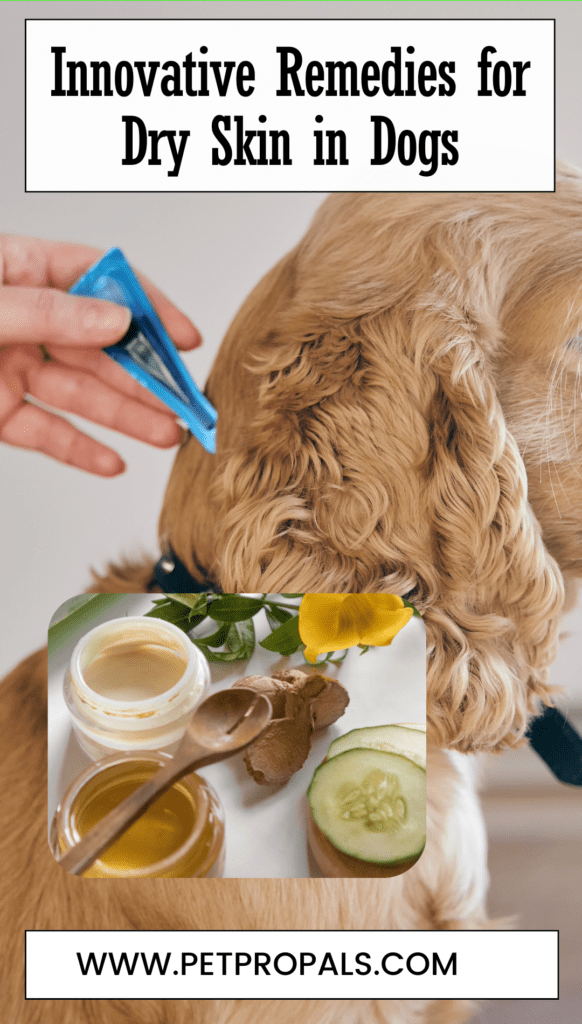
Dry skin in dogs can be effectively managed with natural remedies that provide soothing relief and promote skin health. Explore these innovative solutions to help your furry companion stay comfortable and hydrated.
1. Aloe Vera and Chamomile Mist
How to Make and Apply:
Ingredients: Fresh Aloe Vera gel (from the plant) & Chamomile tea (cooled)
Preparation: Mix equal parts of fresh Aloe Vera gel with cooled chamomile tea in a spray bottle.
Application:
- Shake the bottle well before use.
- Spritz the mist onto your dog’s dry skin, focusing on irritated spots.
- Allow it to air dry.
- Avoid licking until dry to prevent ingestion.
2. DIY Herbal Infused Oil
Here are the detailed instructions for creating and using:
Ingredients:
- Carrier oil (e.g., olive oil, coconut oil)
- Herbs (e.g., calendula, lavender)
Preparation:
- In a clean jar, combine the carrier oil with dried or fresh herbs.
- Seal the jar and place it in a warm, sunny spot for 1-2 weeks to infuse.
Application:
- 1. Strain the infused oil using a fine mesh sieve or cheesecloth.
- 2. Rub a small amount of the oil onto your dog’s dry skin as needed.
- 3. Store the leftover oil in a cool, dark place for later use.
3. Yogurt and Honey Mask
Here are the Preparation and Application Steps:
Ingredients:
- Plain yogurt (unsweetened)
- Raw honey
Preparation:
- Mix equal parts of plain yogurt and raw honey until well combined.
Application:
- Apply the mask to your dog’s clean, dry skin, focusing on areas prone to dryness.
- Leave it on for about 10-15 minutes.
- After washing, rinse your skin with lukewarm water and gently pat it dry.
4. Bone Broth Boost
Benefits and How to Incorporate into Diet:
Benefits:
- Bone broth is rich in nutrients like collagen, gelatin, and amino acids, which support skin health and digestion.
- It helps hydrate and soothe dry skin from the inside out.
How to Incorporate into Diet:
- Serve bone broth as a treat or mix it into your dog’s regular food.
- Ensure it’s cooled to room temperature before serving.
- Begin with small amounts and gradually increase based on your dog’s size and preferences.
5. Avocado Oil Massage
Avocado oil contains vitamins and essential fatty acids that deeply water and nourish dry skin. Conducting an avocado oil massage can help alleviate anger and promote healing:
Application: Rub a small quantity of avocado oil in your palms and gently massage the oil into your dog’s dry skin, paying particular attention to areas prone to dryness or irritation.
Massaging improves circulation and allows the oil to penetrate the skin effectively.
Benefits: Avocado oil’s antioxidants and anti-inflammatory properties help minimize itching and inflammation. It also creates a barrier to preserve moisture and promote skin recovery.
6. Turmeric and Coconut Oil Paste
Turmeric and coconut oil combine to create a potent paste that soothes dry, irritated skin in dogs:
Ingredients: Turmeric powder, Coconut oil
Preparation: Mix turmeric powder with coconut oil until it forms a thick paste.
Application:
- Administer the paste to the impacted regions of your dog’s parched skin.
- Allow it to sit for 15-20 minutes.
- Wash off with lukewarm water and delicately pat dry.
Turmeric’s natural anti-inflammatory and antimicrobial properties and coconut oil’s moisturizing effects make this paste beneficial for managing dry skin in dogs.
7. Cucumber and Aloe Vera Gel
Cucumber and aloe vera gel provides a calming and refreshing solution to alleviate dry, itchy skin in dogs.
Ingredients: 1. Fresh cucumber (peeled and diced) 2.Aloe vera gel (pure and natural)
Preparation: 1. Blend the diced cucumber until smooth. 2. Mix equal parts of cucumber puree with aloe vera gel in a bowl.
Application:
- Apply the mixture to clean, dry areas of your dog’s skin.
- Allow it to sit for 10-15 minutes.
- Rinse off with lukewarm water and gently pat dry.
Cucumber hydrates and cools the skin, while aloe vera gel soothes and moisturizes, making this blend ideal for relieving dry skin symptoms in dogs.
8. DIY Beeswax Balm
Beeswax balm is a natural solution that forms a protective barrier while moisturizing dry and cracked dog skin. It can be made and used as follows:
Ingredients:
- Beeswax pellets or grated beeswax
- Coconut oil or olive oil
- Shea butter (optional for added moisture)
Recipe:
- Melt the exact amounts of beeswax and coconut oil (or olive oil) together in a double boiler.
- Stir until thoroughly combined and melted.
- Optional: Add shea butter for additional moisturizing benefits.
Application:
- Let the mixture cool down a bit, but keep it in liquid form.
- Apply a thin layer to your dog’s dry skin, massaging gently.
- Allow the balm to solidify and form a protective layer.
9. Probiotic Supplements
Boost your dog’s immune system and promote healthier skin from the inside with the help of probiotic supplements.
Benefits:
- Probiotics promote healthy gut flora, reducing inflammation and enhancing nutrient absorption.
- Improved gut health may alleviate skin issues, including dryness and itching.
How to Introduce:
- Choose a high-quality probiotic supplement recommended by your veterinarian.
- Remember to adhere to the dosage guidance on the supplement’s packaging or as directed by your veterinarian.
- Introduce gradually into your dog’s diet to monitor any digestive changes.
10. Green Tea Rinse
The anti-inflammatory properties of green tea can relieve irritation and discomfort in a dog’s skin.
Preparation: Make a potent brew of green tea and allow it to cool completely.
How to Use:
- After bathing your dog, pour the cooled green tea over their coat, focusing on dry or itchy areas.
- Gently massage the tea into the fur and skin.
- Allow your dog to air dry or gently pat dry with a towel.
Green tea’s antioxidants can help reduce inflammation and relieve dry skin symptoms in dogs.
Hydration and Diet for Dogs with Dry Skin
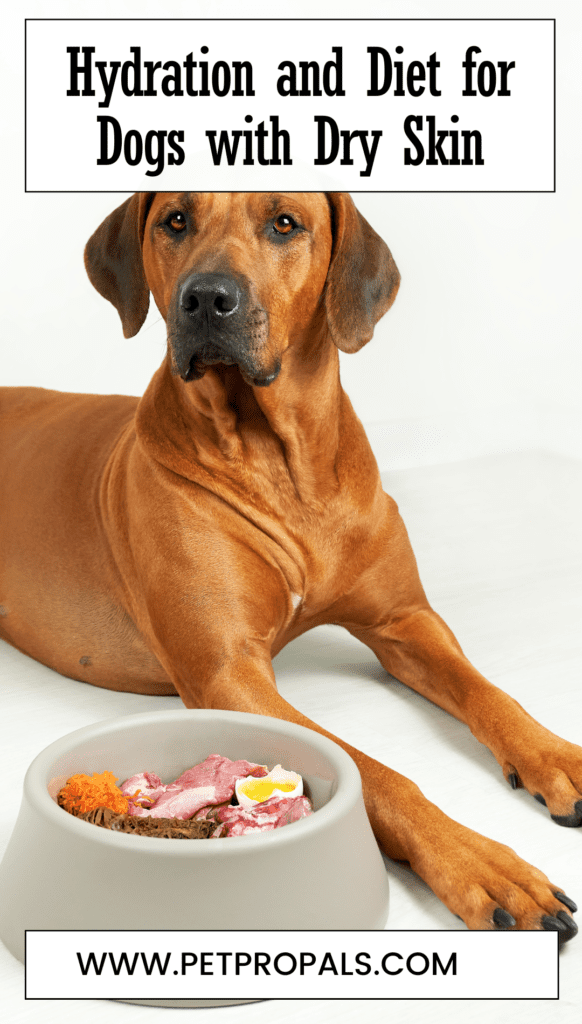
Ensuring adequate hydration and a well-rounded diet is essential for caring for dry skin in dogs.
Here’s how you can ensure your furry companion stays hydrated and receives the necessary nutrients to support healthy skin:
Importance of Hydration
Proper hydration is essential for overall health and skin hydration in dogs.
Dehydration can worsen dry skin conditions, leading to itchiness and discomfort.
Make sure your dog can always reach clean, fresh water, mainly when it’s warmer or when they’re being active.
Tips for Ensuring Adequate Hydration:
Provide Fresh Water: Always have a bowl of fresh water for your dog.
Monitor Water Intake: Track how much water your dog drinks daily. Changes in water intake can indicate health issues.
Consider Wet Food: Wet dog food contains more moisture than dry kibble, contributing to overall hydration.
Importance of Diet
A well-rounded nutrition containing essential nutrients helps maintain the skin’s health and can relieve dryness in dogs.
Incorporate foods abundant in omega fatty acids, antioxidants, and vitamins to enhance skin moisture and flexibility.
Tips for a Skin-Healthy Diet:
Omega Fatty Acids: Include foods abundant in omega-3 and omega-6 fatty acids, like fish (such as salmon and sardines), flaxseed, and chia seeds.
Protein-Rich Foods: Ensure your dog’s diet includes high-quality protein sources like lean meats (chicken, turkey), which are essential for skin repair and regeneration.
Antioxidant-Rich Foods: Place to incorporate high-antioxidant fruits and vegetables such as blueberries, spinach, and carrots to counteract free radicals and promote skin wellness.
Hydrating Treat Ideas:
Frozen Treats: Make homemade frozen treats using plain yogurt and blended fruits like bananas or strawberries. Freeze the mixture in ice cube trays for a delightful and excellent snack.
Broth Ice Cubes: Freeze low-sodium chicken or beef broth into ice cube trays. Offer these as occasional treats to encourage hydration.
Consulting Your Veterinarian
Seek guidance from your veterinarian for personalized recommendations on addressing your dog’s dry skin by focusing on hydration and diet.
They can suggest dietary changes or supplements customized to your dog’s requirements, guaranteeing the best nutrition for its healthy skin and overall health.
Humidifiers for Dogs with Dry Skin
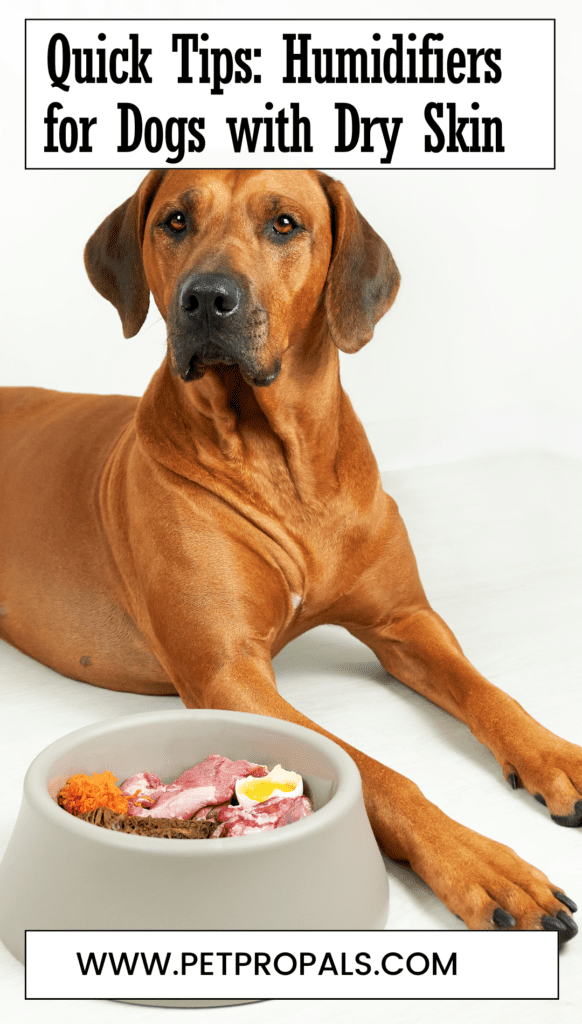
Humidifiers can be beneficial in alleviating dry skin issues in dogs, especially during dry winters or in arid climates. Here’s how using a humidifier can help improve your dog’s skin health and overall comfort:
How Humidifiers Help
Humidifiers increase the moisture levels in the air, helping prevent it from becoming too dry. Dry air can exacerbate dry skin conditions in dogs, leading to itchiness, flakiness, and discomfort.
Benefits of Using a Humidifier:
Moisturizes the Air: Adding moisture to the indoor air prevents it from drying your dog’s skin.
Relieves Dryness: Helps alleviate dry, itchy skin by moisturizing the air.
Improves Comfort: This creates a more comfortable environment for your dog, especially during dry seasons.
Choosing the Right Humidifier
When selecting a humidifier for your home, consider these factors:
Size and Capacity: Choose a humidifier suitable for the size of the room where your dog spends most of their time.
Type of Humidifier: Options include evaporative, ultrasonic, or steam vaporizers. Ultrasonic humidifiers are often quieter, which may be more suitable for pets.
Maintenance: Regularly clean and refill the humidifier to prevent mold and bacteria growth.
Using a Humidifier Safely
To ensure safe and effective use of a humidifier for your dog:
Monitor Humidity Levels: Try maintaining indoor humidity between 30% and 50%. Excessive moisture can also cause problems.
Place Strategically: Position the humidifier where your dog spends the most time, such as their sleeping area or a room they frequent.
Clean Regularly: Follow manufacturer instructions for cleaning to maintain air quality and prevent mold or bacteria buildup.
Consulting Your Veterinarian
If your dog has persistent dry skin issues despite using a humidifier and other remedies, consult your veterinarian.
Personalized guidance and suitable treatments or changes can be suggested to enhance your dog’s skin wellness.
Regular Grooming for Dogs with Dry Skin
Regular grooming significantly influences the health of your dog’s skin and manages dry skin conditions. Consistent grooming practices can provide essential benefits for your furry friend.
Importance of Regular Grooming
Removes Dead Skin and Hair: Regular brushing helps remove dead skin cells and loose hair, preventing them from accumulating and causing irritation.
Stimulates Oil Production: Brushing stimulates the skin and promotes natural oil production, which helps moisturize and protect the skin.
Detects Skin Issues Early: During grooming sessions, you can inspect your dog’s skin for any abnormalities, such as dry patches, redness, or signs of irritation. Early detection allows for prompt treatment.
Tips for Grooming Dogs with Dry Skin
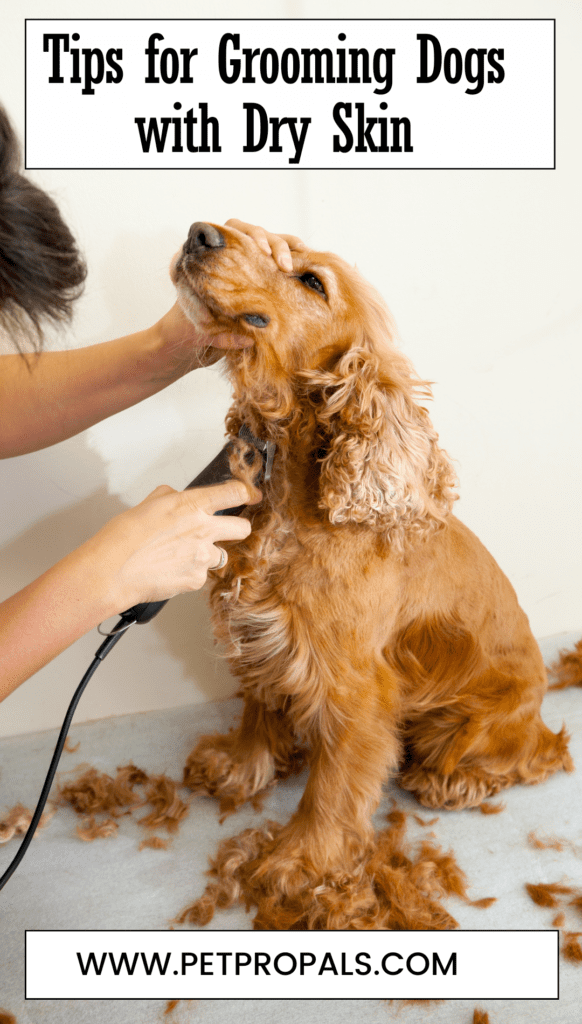
Choose the Right Brush: Use a brush suitable for your dog’s coat type. Soft bristle brushes are gentle on sensitive skin, while de-shedding tools can help manage excessive shedding.
Bathe Appropriately:
It is designed for dogs, so use a moisturizing shampoo for dry skin. Refrain from bathing your dog too often, as this can eliminate natural oils from the skin. Choose lukewarm water and Ensure thorough rinsing is performed to avoid leaving any residue.
Trim Nails and Hair: Long nails can cause discomfort and affect your dog’s gait. Regularly trim nails and trim the hair around paws and ears to prevent matting and moisture retention.
Additional Grooming Tips
Ear Care: Clean your dog’s ears regularly to prevent infections. Use a veterinarian-recommended ear cleaner and gently wipe the outer ear with a cotton ball or pad.
Dental Care: Brush your dog’s teeth regularly to maintain oral health. Dental issues can contribute to overall health problems, including skin conditions.
Skin Moisturization: Consider using dog-safe moisturizing sprays or balms, especially in areas prone to dryness, such as elbows and nose.
Consulting Your Veterinarian
If your dog continues to experience dry skin despite regular grooming and other measures, consult your veterinarian.
They can assess underlying causes, such as allergies or dermatological conditions, and recommend appropriate treatments or adjustments to your grooming routine.
Environmental Adjustments
Environmental adjustments are essential for dogs with dry skin. Use a humidifier indoors to optimize humidity levels and prevent dry air from worsening skin conditions.
Use moisturizers and gentle, hydrating shampoos that are safe for dogs. Regular grooming, such as brushing and cleaning ears, can also help manage dryness. Consult your vet for personalized advice on dealing with ongoing dry skin.
DIY Skin Soothing Sprays
DIY skin-soothing sprays can provide relief for dogs with dry skin, offering gentle yet effective natural solutions.
Ingredients like aloe vera, coconut oil, and chamomile can help moisturize and soothe irritated skin. These sprays are easy to make at home and can be applied directly to affected areas for quick relief.
Conclusion
With the proper remedies and preventative measures, caring for your dog’s dry skin naturally during winter can be practical and gentle.
Remember, you can help reduce discomfort and promote healthy skin by adjusting your dog’s diet, keeping up with regular grooming sessions, and using soothing natural remedies like oatmeal baths, coconut oil, and herbal sprays.
Remember that each dog is unique. You must notice how they react to treatments and consult your veterinarian for ongoing problems to ensure tailored care.
With these steps, you can keep your furry companion comfortable and happy throughout the colder months, allowing them to enjoy the season without the discomfort of dry, itchy skin.

